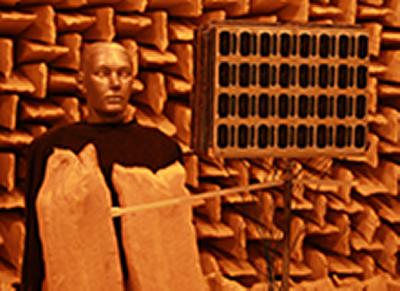TV sound system for the hard of hearing

Families often watch TV together, but what happens when one member has hearing difficulties? Usually the result is a compromise on listening volume that doesn't really satisfy anyone.
To solve this problem, a University of Southampton researcher has developed a loudspeaker system to help people with hearing problems listen to television without affecting the sound for other viewers.
Marcos Simón, a PhD researcher from the University’s Institute of Sound and Vibration Research, has devised a highly-directional system of acoustical radiators, commonly known as loudspeaker arrays, which produce a sound ‘hot spot’ by boosting the audio signal in the area of a room where a hearing impaired person is sitting but maintaining the same audio levels elsewhere.
Marcos says: “It’s estimated that disputes over TV volume affect one in 10 households, and these are often caused by some family members having age-related hearing loss.
“Because only about 20 per cent of such people wear hearing aids, the only way to resolve this problem is to improve the level of sound for them without annoying other viewers in the household with normal hearing who don’t want to be subjected to a loud volume.”
Marcos’s loudspeaker design, which comprises eight phase-shift sources in a line, aims to compensate for the hearing loss of a 70-year-old adult, which is of about 15 dB at 3 kHz.
The acoustical radiators send a boosted version of the TV audio towards one location, where a hearing impaired TV listener is present. Other listeners with healthy hearing are placed at positions where they do not listen to the amplification provided by the array.
Marcos, who won the 2013 Institute of Acoustics (IOA) Young Person’s Award for Innovation in Acoustical Engineering for his array design, says: “Although line arrays have been studied for many years, the approach previously used to reduce the radiation to the rear of the array – and hence reduce reverberant levels for other listeners – has been to position a second set of loudspeakers at the back of the array to cancel the sound in that direction.
“My array uses individual loudspeaker elements that are specially designed first-order acoustic radiators, or phase shift sources, thus saving cost and improving the robustness of the array to variations in the sensitivity of the elements and in the reproduction environment."
The operation of the array has been tested by performing behavioural experiments in a normal room, and it has been seen that using the device it is possible obtain about a 30 per cent of speech intelligibility improvement of the hearing impaired listeners, while maintaining a good audio quality in the zone where the healthy listeners are sat.
Marcos adds: “This is quite an encouraging result, as it confirms that it is possible to use the array as a complementary aid for the hard of hearing. This means a 70-year old person can listen to a TV programme normally without disturbing others around them.”